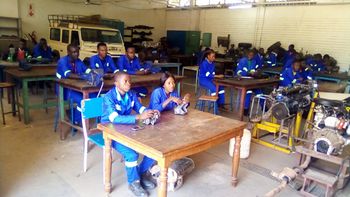CTVSD5/Introduction/Plan
Contents
Plan learner support appropriate to the cohort
How to incorporate required learner supports into training design
By being aware of your learner cohort/group, and any possible supports they may require you are able to build this into your training resources.
Synchronous
Synchronous support is given at the time. An example may be a workplace where the trainer is working with the learner/s to explain and discuss a method of operating a machine. The questions and answers are immediate and demonstrations can occur.
Other examples of synchronous supports include:
- be aware of being face to face when speaking to someone with impaired hearing
- providing feedback as a task being performed
- having a workplace buddy system.
Asynchronous Asynchronous is not at the same time. Asynchronous support may be an online forum where you post a question and receive a reply at a later point in time. A delayed response is experienced.
Other examples of asynchronous supports include:
- factor in additional time for completion of tasks if language may be an issue, or family responsibilities are distracting from learning
- support the learning of technology to complete tasks – provide a computer so the learner can engage in training, refer the student for additional computer lessons to build skills for the study and workplace.
Be aware of limitations and challenges they may present. In this situation, the support or modification can be identified and made prior to the learner accessing the support.
What are you supporting?
Once you have an understanding of who your students are, and what support they may require you are able to consider how you incorporate your support methods into the delivery of the message.
Consider how and where you will incorporate support into:
- training and assessment
- technological
- accessibility
Considerations for digital literacy
What is digital literacy?
Digital literacy refers to an individual's ability to find, evaluate, and clearly communicate information through typing and other media on various digital platforms. It is evaluated by an individual's grammar, composition, typing skills and ability to produce text, images, audio and designs using technology.
Source: Digital literacy - Wikipedia 17/6/2021
Consider: Will your students be required to have a level of digital literacy to be able to study/work with you? Does the role require existing skills to be held, or will you include time to teach students what they need to know?
Evaluating digital literacy Depending on the needs of the organisation for digital literacy multiple tools are available on the internet, or you may decide to build a simple questionnaire to check your student’s knowledge around the specific skill sets they require to carry out the job or learning.
Considerations for accessibility
WCAG
Where you are using technology, such as a website to support the delivery of your learning material, you should consider the Web Content Accessibility Guidelines (WCAG) 2.1. This is an internationally recognised standard developed to support making web content more accessible for a wider range of people including vision, hearing, speech and combinations. The guidelines address accessibility for web content which is available over the various platforms i.e. computer, laptop and mobile. Created by the World Wide Web Consortium (W3C) and originally published in 1999, a new update is now available, WCAG2.1 was released in 2018.
There are four (4) design principles of WCAG which are:
- Perceivable: Information is to be presented so that it can be understood
- Operable: Your site can be navigated
- Understandable – information and operation is understandable
- Robust – a wide range of people and assistive technologies can interpret the information reliably.
Under the Principles are Guidelines to provide further support in understanding how you can further support people to use your web site.
Physical disability
If a student has a physical impairment assess the following:
- Will they be able to participate?
- What changes may they require to the physical space, or any learning material?
- Will they be able to participate in the process and meet the outcomes required?
- Will your environment or the learning material need to be modified to support your learner?
Reasonable adjustment
To support a learner with a disability, consider what changes, if any, you need to make to your environment, materials or operations to support them to meet the outcomes.
